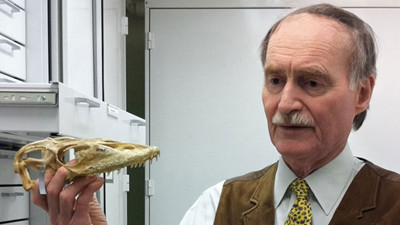法里什·詹金斯
Farish Jenkins, paleontologist and polymath, died on November 11th aged 72
法里什·詹金斯,古生物學家、博學者,卒于11月11日,享年72歲
INDIANA JONES is the ultimate action -hero academic: played by Harrison Ford, the indomitable professor outwits Nazis and other villains in search of religious relics, lost temples and alien artefacts. Farish Jenkins preferred a rifle to a bullwhip, and it was palaeontology, not archaeology, that he made glamorous. But he did have a stylish hat, a military background and adventures in wild places. His adoring students dubbed him the real life version of the cinematic creation.
由哈里森·福特出演的印第安納·瓊斯是動作片中最出色的學者主人公:這位不屈不撓的教授在尋找宗教遺物、失落的寺廟和天外文物的過程中以智慧戰勝了納粹和其他壞人。比起牛鞭,法里什·詹金斯更喜歡步槍,而且他是一位出色的古生物學家,而非考古學家。不過他的確擁有一頂時髦的帽子,也是軍人背景出身,也有過在野外冒險的經歷。崇拜他的學生稱他為電影人物的真人版。

A Marine Corps captain, he trained as an artillery officer, “cascading expensive, high explosive ordnance onto stockpiles of junk cars”. Unlike most modern academics, he defied categorisation into narrow specialism. A “hybrid” as he put it, he was anatomist, zoologist and vertebrate palaeontologist in equal measure.
他是一名海軍陸戰隊的隊長,但卻接受過和炮兵軍官一樣的訓練,“將大量昂貴的高爆炸性軍械放置到垃圾車的儲備軍火中”。和大多數現代的學術研究者不同,他反對那種把學科分為狹窄類別的做法。他在解剖學、動物學、脊椎動物古生物學上的造詣都同樣高深。用詹金斯自己的話來說,他是一名“雜學家”。
Arriving at Yale to study geology in 1964, he was told that all major aspects of vertebrate evolution were already understood. He feared that he and his friends would be left “to build our careers with carefully stacked minutiae”. In fact, “titanic” discoveries awaited. But to crack the secrets of the fossil world, he had to master not only the rocks but the organisms they hid. He was the first Yale Graduate School student to cross over to the Medical School, to study anatomy and embryology.
1964年,詹金斯進入耶魯大學學習地質學,有人告訴他,所有有關脊椎動物進化的主要方面都已被研究透了。他曾擔心他和他的朋友只能“通過那些小心翼翼堆積起來的細枝末節來構筑他們的事業”。事實上,“重大的”發現還在前方等著他們。但想要挖出化石世界的秘密,他不僅要精通巖石方面的知識,還要了解藏在這些巖石中的生物的習性。他是耶魯大學研究生院第一個跨學科去醫學院學習解剖學和胚胎學的學生。
Later, he illustrated his lectures with fine anatomical drawings, painstakingly rendered with what he proudly called Harvard's best collection of sharpened chalks (he was not a PowerPoint person). When necessary, he would draw bones and muscles on his own suit. To illustrate the body's natural shock-absorbers, he would stomp round the room on a peg leg, reading the description of Captain Ahab's gait in “Moby Dick”. Students loved that, and how he timed his lectures to the second.
后來在講課時,他會不辭辛苦地用粉筆畫出精妙的解剖圖,還驕傲地把用過的粉筆頭稱作是“哈佛大學最佳尖頭粉筆收集品”。必要的時候,他會把骨骼和肌肉畫在自己的西裝上。為了展示人體自帶的減震器,他會用木制假腿在教室里跺著腳走來走去,一邊讀著《白鯨記》中描述亞哈船長步態的語句。學生們喜歡他這樣做,也佩服他能準確地掌控講課時間,毫秒不差。
He had no time for academic squabbles and protocol, brushing off rebukes and bureaucratic constraints. Charm was his first weapon, obstinacy his second. It was not just his clothes and vocabulary that were old-fashioned. He prized thoroughness. Unusually for modern academia, he showered praise on colleagues and deprecated his own triumphs. But he was a mighty foe when roused. He could swear like a Marine, “without repeating myself” and helped oust the abrasive Larry Summers from the Harvard presidency.
他沒有時間來應付學術爭吵和學術禮節,對別人的指責和官僚政治的約束視而不見。魅力是他的第一大武器,固執次之,在他身上,過時的不僅僅只是衣服和詞匯而已。他很珍視認真詳細這一點。他時常贊揚自己的同事,卻認為自己的成功不屑一提,這在當今學術界是很不尋常的。但他可不是好惹的。他會像海軍一樣破口大罵,“老子只說一遍”,他還幫忙將粗魯的拉里·薩默斯④從哈佛大學校長的職位上趕了下去。
The first field trip was to Africa, where his “very close and extremely naive encounters” with the local fauna included a self-portrait with a black rhino (plentiful as “rats in a dump” in those days). The beast took offence and charged; Mr Jenkins made it back to his car minus a lens cap. Living vertebrates, he decided, were just as interesting as their extinct relatives.
他的第一次實地考察去的是非洲,雖然經驗不足,但他還是近距離地接觸到了當地的動物群,還在那里畫了一張與黑犀牛的自畫像。當時黑犀牛因惱怒猛沖了過來,詹金斯先生逃回了汽車中,卻丟了一個鏡頭蓋。他確信,活著的脊椎動物和它們已經滅絕的親屬一樣有趣。
High speed cineradiography, plus treadmills and a wind tunnel gave him new insights into how animals move: walking, trotting, galloping, flying and brachiating (the way monkeys swing). His efforts reached, he said proudly, “circus-like” proportions. “Tree shrews ricocheted across my bookshelves and desk,” he recalled. University bosses were appalled. His students and colleagues were captivated.
高速的放射性電影照相術加上踏車和風洞使他找到了研究動物運動方式的新角度:散步、慢跑、疾馳、飛翔以及用臂膀吊蕩樹枝前進。他驕傲地說,他通過努力達到了“馬戲團一般的”規模。“樹鼩在我的書架和書桌上跳來跳去”,他回憶道。學校里的領導為此而震驚,他的學生和同事卻因此而著迷。
But fieldwork was even more fun. The most arduous expeditions were to east Greenland and arctic Canada, armed with lavatory paper to wrap the fossils, and chocolate bars for the diggers. Mr Jenkins was a distinctive addition to the landscape: invariably well-dressed, and sporting a beloved Czechoslovak rabbit-fur hat, a pocket-watch, a flask of vodka and a gun. He rigged trip wires and automatic rifle fire to deter polar bears from the camp at night. A cast of a huge paw print in his office was a souvenir of a particularly narrow escape.
但更有趣的要數野外工作。對詹金斯來說,最艱難的探險莫過于去東格陵蘭島和加拿大北極地區的那次。當時他身上帶著用來包裹化石的衛生紙和為挖掘工作者準備的巧克力棒。他為那兒的景色添加了獨特的一筆:他總是穿得十分得體,神氣活現地戴著他鐘愛的捷克斯洛伐克兔皮帽,還有一只懷表、一瓶伏特加和一把槍。他用絆網和自動步槍的掃射來阻止北極熊在夜間闖入營地。在他的辦公室里,放著一個巨大爪印的金屬鑄模,用來紀念他曾艱難地從“熊”口脫險。
The trophies of those trips were carefully chipped open at Harvard. One proved to be the great find of his life: Tiktaalik roseae. “Rose” was the Christian name of an anonymous benefactor who subsidised the expeditions. Tiktaalik was a homage to his Inuit hosts: their word for a large freshwater fish. In fossil-speak the discovery was “the elpistostegalian central to understanding the emergence of tetrapods”. In layman's language, it was a 375m-year-old fish with legs, a rudimentary ear and a snout for catching prey—a vital clue to how living beings first moved from sea to land.
這些旅途的戰利品都被小心翼翼地展出在哈佛大學。其中一個是他一生中的重大發現:提塔利克魚。其中的“rose”是捐助此次探險的一位匿名人士的教名,Tiktaalik則是為了向探險時招待過他們的主人因紐特人致敬:在因紐特人的語言中,該詞的意思是“一種很大的淡水魚”。用化石學中的話來說,此次發現的是“對理解四足動物的出現十分重要的希望螈類生物”。用外行人的話來解釋,提塔利克魚距今已有3.75億年歷史,身上長著腳和未進化完全的耳朵以及用來捕食獵物的鼻口部—它為人們研究生物最初如何從海洋進化到陸地上來提供了重要的線索。
Smart man
智慧之人
Another big find was what he called the “ugliest animal in the world”. It was a 210m-year-old armoured marine creature. Mr Jenkins spotted its distinguishing feature: that it opened its mouth by lifting its upper jaw. He was crucial in discovering the world's earliest known frog, which unlike its salamander-like ancestors had hind legs for jumping. He found that in 1981 in the Arizona desert. It initially looked like “road kill”, his colleague Neil Shubin said: a 190m-year-old mash of four different frog skeletons. The two men spent the next 14 years picking them apart and putting them back together. They named their find Prosalirus bitis, combining a Latin word meaning “leap forward” with a Navajo word for “high above it”.
詹金斯稱他的另一個重大發現為“世界上最丑的動物”。這種有著堅硬外殼的海洋生物距今已有2.1億年。詹金斯先生發現了這種生物所獨有的特征:通過抬起上頜來張嘴。在發現人類已知的最早的蛙類上詹金斯也扮演了十分關鍵的角色,這種蛙類和它的祖先蠑螈不同,它沒有用來彈跳的后肢。1989年,詹金斯在亞利桑那沙漠發現了這種生物。他的同事尼爾·舒賓說,最初他們發現這種生物時,它們看起來像是“被車壓死的”:四只距今已有1.9億年的蛙類的骨骼被壓碎了攪在一起。詹金斯和舒賓兩個人花了14年的時間把這些骨骼分開,又重新組合在一起。他們將這種蛙類命名為Prosalirus bitis,這一名字由拉丁文中的“向前跳”和納瓦霍語中的“高于某物”組合而成。
After a bout of cancer he dismissed a visitor's worries, saying: “as a palaeontologist, I'm familiar with extinction.” In his spare time he trapped the chipmunks that infested his barn and made prodigious quantities of cider from his own apples.
在詹金斯癌癥病發之后,有人憂心忡忡地來探望他。他寬慰對方說:“作為一位古生物學家,我對‘滅絕'可是熟悉得很”。他曾在空閑的時候誘捕侵入谷倉的花栗鼠,也曾用自己種的蘋果釀造了數量可謂多得驚人的蘋果酒。












